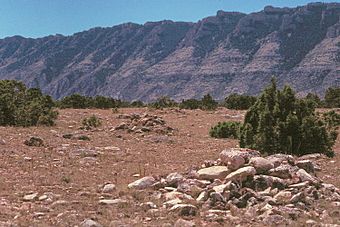Bad Pass Trail facts for kids
Quick facts for kids |
|
|
Bad Pass Trail
|
|

Rock cairn on the Bad Pass Trail, Montana
|
|
| Nearest city | Lovell, Wyoming |
|---|---|
| Area | 5,372.3 acres (2,174.1 ha) |
| NRHP reference No. | 75000215 |
| Added to NRHP | October 29, 1975 |
The Bad Pass Trail, also known as the Sioux Trail, is an ancient path used for thousands of years. It crosses the border between what is now Montana and Wyoming. Native Americans first created this trail. It helped them travel from the Bighorn Basin in Wyoming. They used it to reach important bison hunting areas in Montana.
Contents
Discovering the Bad Pass Trail
This historic trail is marked by special stone piles called cairns. It leads across a place known as Bad Pass. People have used this trail for a very long time, possibly for ten to twelve thousand years! This means it was used long before Europeans arrived in America.
Who Used This Ancient Path?
After Europeans came to the area, the trail was still very popular. Fur trappers and mountain men started using it around 1824. These adventurers would gather their supplies and pack animals near the Shoshone River and the Bighorn River.
The Bad Pass Trail helped them avoid the difficult Bighorn Canyon. Once they reached the end of the trail at Grapevine Creek, they could float down the Bighorn River on rafts. This journey would take them to the Yellowstone River, then to the Missouri, and finally to St. Louis.
Clues Along the Trail
Today, you can still find about 300 stone cairns along the trail. Many are located within the Bighorn Canyon National Recreation Area. People believe these cairns grew over time. Travelers would add a stone to the pile for good luck as they passed by.
Even though some parts of the trail have changed, it still runs along the western side of Bighorn Canyon. Along the trail, archaeologists have found as many as 1,000 tipi rings. These are circles of stones that once held down the edges of Native American tipis. These rings give us clues about how people lived and traveled here long ago.
A Recognized Historic Site
The Bad Pass Trail is an important part of American history. Because of its long history and cultural importance, it was added to the National Register of Historic Places on October 29, 1975.



